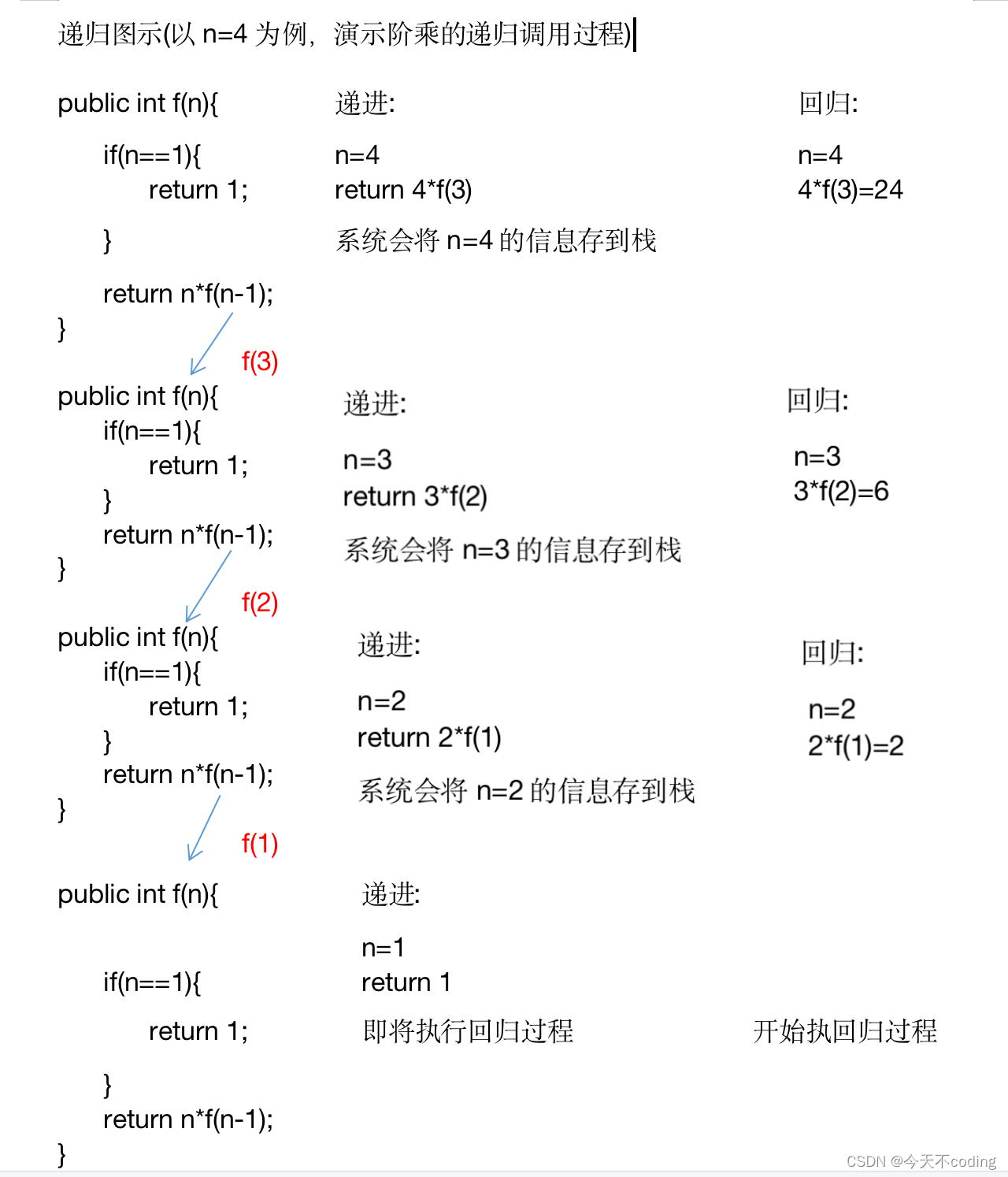在本博客中,你将学习创建一个 LangChain 应用程序,以使用 ChatGPT API 和 Huggingface 语言模型与多个 PDF 文件聊天。
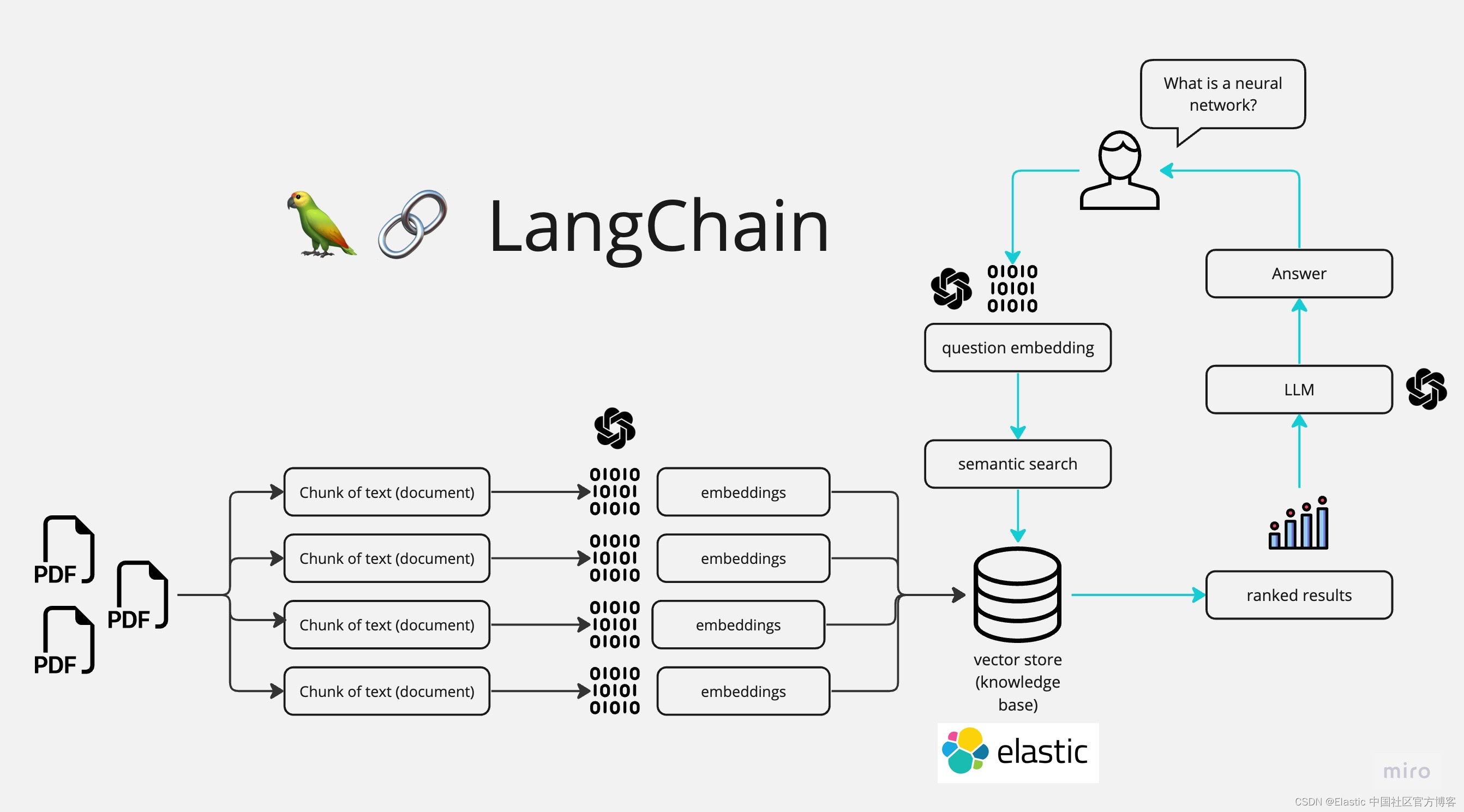
如上所示,我们在最最左边摄入 PDF 文件,并它们连成一起,并分为不同的 chunks。我们可以通过使用 huggingface 来对 chunks 进行处理并形成 embeddings。我们把 embeddings 写入到 Elasticsearch 向量数据库中,并保存。在搜索的时候,我们通过 LangChain 来进行向量化,并使用 Elasticsearch 进行向量搜索。在最后,我们通过大模型的使用,针对提出的问题来进行提问。我们最终的界面如下:
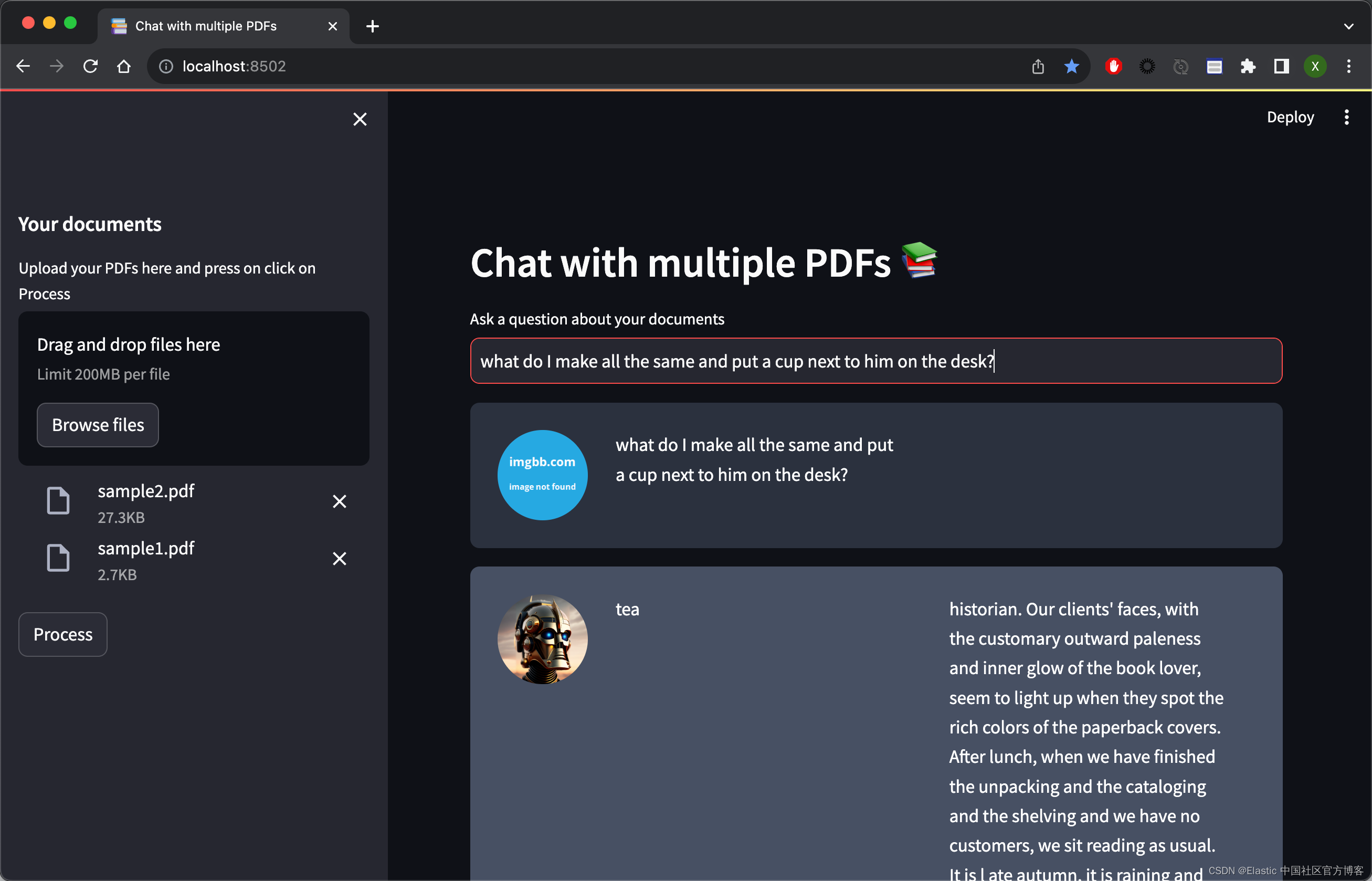
如上所示,它可以针对我们的问题进行回答。进一步阅读
- 使用 LangChain 和 Elasticsearch 对私人数据进行人工智能搜索
-
使用 LangChain 和 Elasticsearch 的隐私优先 AI 搜索
所有的源码可以在地址 GitHub - liu-xiao-guo/ask-multiple-pdfs: A Langchain app that allows you to chat with multiple PDFs 进行下载。
安装
如果你还没有安装好自己的 Elasticsearch 及 Kibana 的话,那么请参考如下的链接:
-
如何在 Linux,MacOS 及 Windows 上进行安装 Elasticsearch
-
Kibana:如何在 Linux,MacOS 及 Windows 上安装 Elastic 栈中的 Kibana
在安装的时候,我们选择 Elastic Stack 9.x 的安装指南来进行安装。在默认的情况下,Elasticsearch 集群的访问具有 HTTPS 的安全访问。
在安装时,我们可以在 Elasticsearch 的如下地址找到相应的证书文件 http_ca.crt:
$ pwd
/Users/liuxg/elastic/elasticsearch-8.10.0/config/certs
$ ls
http.p12 http_ca.crt transport.p12我们需要把该证书拷贝到项目文件的根目录下:
$ tree -L 3
.
├── app.py
├── docs
│ └── PDF-LangChain.jpg
├── htmlTemplates.py
├── http_ca.crt
├── lib_embeddings.py
├── lib_indexer.py
├── lib_llm.py
├── lib_vectordb.py
├── myapp.py
├── pdf_files
│ ├── sample1.pdf
│ └── sample2.pdf
├── readme.md
├── requirements.txt
└── simple.cfg如上所示,我们把 http_ca.crt 拷贝到应用的根目录下。我们在 pdf_files 里放了两个用于测试的 PDF 文件。你可以使用自己的 PDF 文件来进行测试。我们在 simple.cfg 做如下的配置:
ES_SERVER: "localhost"
ES_PASSWORD: "vXDWYtL*my3vnKY9zCfL"
ES_FINGERPRINT: "e2c1512f617f432ddf242075d3af5177b28f6497fecaaa0eea11429369bb7b00"在上面,我们需要配置 ES_SERVER。这个是 Elasticsearch 集群的地址。这里的 ES_PASSWORD 是 Elasticsearch 的超级用户 elastic 的密码。我们可以在 Elasticsearch 第一次启动的画面中找到这个 ES_FINGERPRINT:
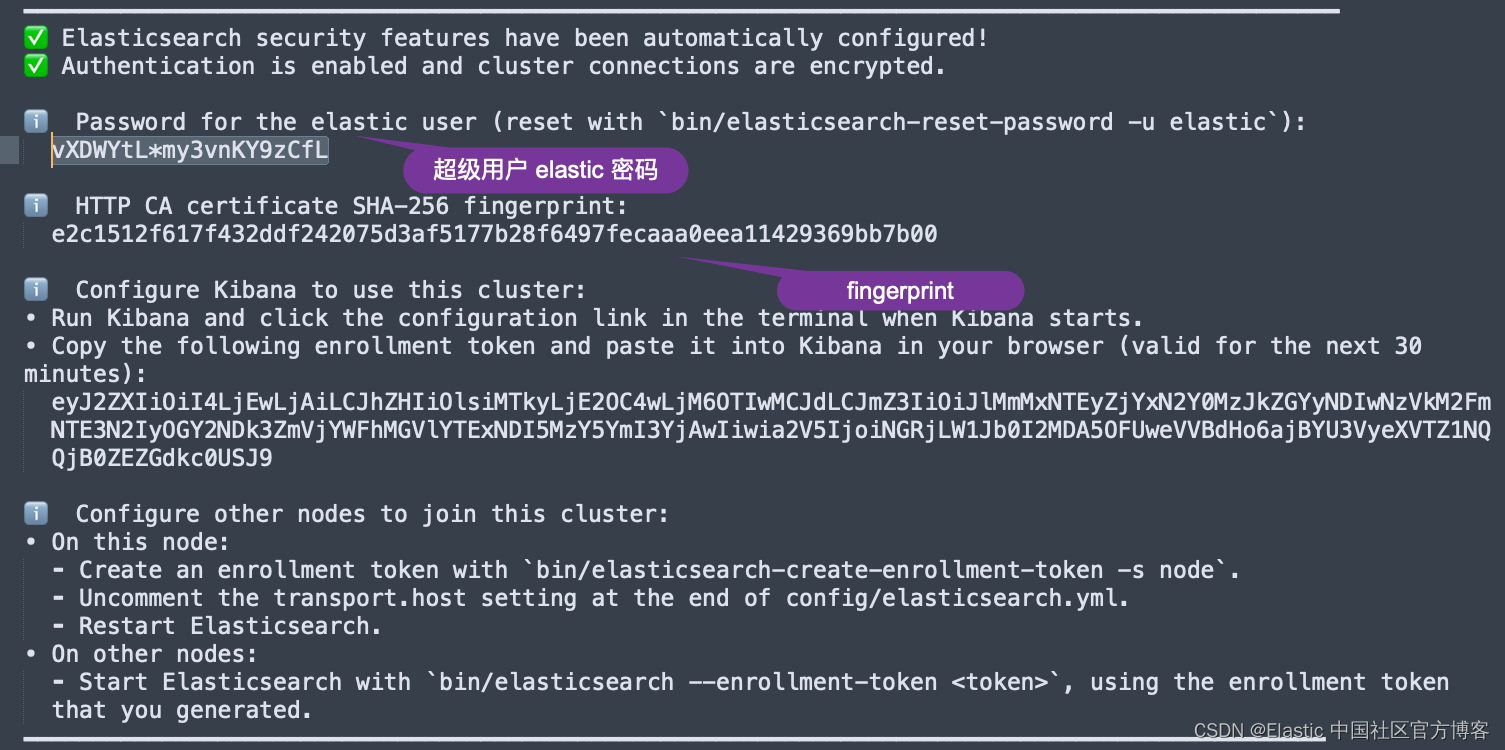
你还可以在 Kibana 的配置文件 confgi/kibana.yml 文件中获得 fingerprint 的配置:

在项目的目录中,我们还可以看到一个叫做 .env-example 的文件。我们可以使用如下的命令把它重新命名为 .env:
mv .env.example .env在 .env 中,我们输入 huggingface.co 网站得到的 token:
$ cat .env
OPENAI_API_KEY=your_openai_key
HUGGINGFACEHUB_API_TOKEN=your_huggingface_key在本例中,我们将使用 huggingface 来进行测试。如果你需要使用到 OpenAI,那么你需要配置它的 key。有关 huggingface 的开发者 key,你可以在地址获得。
运行项目
在运行项目之前,你需要做一下安装的动作:
python3 -m venv env
source env/bin/activate
python3 -m pip install --upgrade pip
pip install -r requirements.txt创建界面
本应用的界面,我们采用是 streamlit 来创建的。它的创建也是非常地简单。我们可以在 myapp.py 中看到如下的代码:
myapp.py
import streamlit as st
from dotenv import load_dotenv
from PyPDF2 import PdfReader
from htmlTemplates import css, bot_template, user_template
def get_pdf_texts(pdf_docs):
text = ""
for pdf in pdf_docs:
pdf_reader = PdfReader(pdf)
for page in pdf_reader.pages:
text += page.extract_text()
return text
def main():
load_dotenv()
st.set_page_config(page_title="Chat with multiple PDFs", page_icon=":books:")
st.write(css, unsafe_allow_html=True)
st.header("Chat with multiple PDFs :books:")
user_question = st.text_input("Ask a question about your documents")
if user_question:
pass
st.write(user_template.replace("{{MSG}}", "Hello, human").replace("{{MSG1}}", " "), unsafe_allow_html=True)
st.write(bot_template.replace("{{MSG}}", "Hello, robot").replace("{{MSG1}}", " "), unsafe_allow_html=True)
# Add a side bar
with st.sidebar:
st.subheader("Your documents")
pdf_docs = st.file_uploader(
"Upload your PDFs here and press on click on Process", accept_multiple_files=True)
print(pdf_docs)
if st.button("Process"):
with st.spinner("Processing"):
# Get pdf text from
raw_text = get_pdf_texts(pdf_docs)
st.write(raw_text)
if __name__ == "__main__":
main()在上面的代码中,我创建了一个 sidebar 用来选择需要的 PDF 文件。我们可以点击 Process 按钮来显示已经提取的 PDF 文本。我们可以使用如下的命令来运行应用:
(venv) $ streamlit run myapp.pyvenv) $ streamlit run myapp.py
You can now view your Streamlit app in your browser.
Local URL: http://localhost:8502
Network URL: http://198.18.1.13:8502运行完上面的命令后,我们可以在浏览器中打开应用:

我们点击 Browse files,并选中 PDF 文件:

点击上面的 Process,我们可以看到:

在上面,我们为了显示的方便,我使用 st.write 直接把结果写到浏览器的页面里。我们接下来需要针对这个长的文字进行切分为一个一个的 chunks。我们需要按照模型的需要,不能超过模型允许的最大值。
上面我简单地叙述了 UI 的构造。最终完整的 myapp.py 的设计如下:
myapp.py
import streamlit as st
from dotenv import load_dotenv
from PyPDF2 import PdfReader
from langchain.text_splitter import CharacterTextSplitter
from langchain.text_splitter import RecursiveCharacterTextSplitter
from langchain.embeddings import OpenAIEmbeddings
from htmlTemplates import css, bot_template, user_template
import lib_indexer
import lib_llm
import lib_embeddings
import lib_vectordb
index_name = "pdf_docs"
def get_pdf_text(pdf):
text = ""
pdf_reader = PdfReader(pdf)
for page in pdf_reader.pages:
text += page.extract_text()
return text
def get_pdf_texts(pdf_docs):
text = ""
for pdf in pdf_docs:
pdf_reader = PdfReader(pdf)
for page in pdf_reader.pages:
text += page.extract_text()
return text
def get_text_chunks(text):
text_splitter = CharacterTextSplitter(
separator="\n",
chunk_size=1000,
chunk_overlap=200,
length_function=len
)
chunks = text_splitter.split_text(text)
# chunks = text_splitter.split_documents(text)
return chunks
def get_text_chunks1(text):
text_splitter = RecursiveCharacterTextSplitter(chunk_size=384, chunk_overlap=0)
chunks = text_splitter.split_text(text)
return chunks
def handle_userinput(db, llm_chain_informed, user_question):
similar_docs = db.similarity_search(user_question)
print(f'The most relevant passage: \n\t{similar_docs[0].page_content}')
## 4. Ask Local LLM context informed prompt
# print(">> 4. Asking The Book ... and its response is: ")
informed_context= similar_docs[0].page_content
response = llm_chain_informed.run(context=informed_context,question=user_question)
st.write(user_template.replace("{{MSG}}", user_question).replace("{{MSG1}}", " "), unsafe_allow_html=True)
st.write(bot_template.replace("{{MSG}}", response).replace("{{MSG1}}", similar_docs[0].page_content),unsafe_allow_html=True)
def main():
# # Huggingface embedding setup
hf = lib_embeddings.setup_embeddings()
# # # ## Elasticsearch as a vector db
db, url = lib_vectordb.setup_vectordb(hf, index_name)
# # # ## set up the conversational LLM
llm_chain_informed= lib_llm.make_the_llm()
load_dotenv()
st.set_page_config(page_title="Chat with multiple PDFs", page_icon=":books:")
st.write(css, unsafe_allow_html=True)
st.header("Chat with multiple PDFs :books:")
user_question = st.text_input("Ask a question about your documents")
if user_question:
handle_userinput(db, llm_chain_informed, user_question)
st.write(user_template.replace("{{MSG}}", "Hello, human").replace("{{MSG1}}", " "), unsafe_allow_html=True)
st.write(bot_template.replace("{{MSG}}", "Hello, robot").replace("{{MSG1}}", " "), unsafe_allow_html=True)
# Add a side bar
with st.sidebar:
st.subheader("Your documents")
pdf_docs = st.file_uploader(
"Upload your PDFs here and press on click on Process", accept_multiple_files=True)
print(pdf_docs)
if st.button("Process"):
with st.spinner("Processing"):
# Get pdf text from
# raw_text = get_pdf_text(pdf_docs[0])
raw_text = get_pdf_texts(pdf_docs)
# st.write(raw_text)
print(raw_text)
# Get the text chunks
text_chunks = get_text_chunks(raw_text)
# st.write(text_chunks)
# Create vector store
lib_indexer.loadPdfChunks(text_chunks, url, hf, db, index_name)
if __name__ == "__main__":
main()创建嵌入模型
lib_embedding.py
## for embeddings
from langchain.embeddings import HuggingFaceEmbeddings
def setup_embeddings():
# Huggingface embedding setup
print(">> Prep. Huggingface embedding setup")
model_name = "sentence-transformers/all-mpnet-base-v2"
return HuggingFaceEmbeddings(model_name=model_name)创建向量存储
lib_vectordb.py
import os
from config import Config
## for vector store
from langchain.vectorstores import ElasticVectorSearch
def setup_vectordb(hf,index_name):
# Elasticsearch URL setup
print(">> Prep. Elasticsearch config setup")
with open('simple.cfg') as f:
cfg = Config(f)
endpoint = cfg['ES_SERVER']
username = "elastic"
password = cfg['ES_PASSWORD']
ssl_verify = {
"verify_certs": True,
"basic_auth": (username, password),
"ca_certs": "./http_ca.crt",
}
url = f"https://{username}:{password}@{endpoint}:9200"
return ElasticVectorSearch( embedding = hf,
elasticsearch_url = url,
index_name = index_name,
ssl_verify = ssl_verify), url创建使用带有上下文和问题变量的提示模板的离线 LLM
lib_llm.py
## for conversation LLM
from langchain import PromptTemplate, HuggingFaceHub, LLMChain
from langchain.llms import HuggingFacePipeline
import torch
from transformers import AutoTokenizer, AutoModelForCausalLM, pipeline, AutoModelForSeq2SeqLM
def make_the_llm():
# Get Offline flan-t5-large ready to go, in CPU mode
print(">> Prep. Get Offline flan-t5-large ready to go, in CPU mode")
model_id = 'google/flan-t5-large'# go for a smaller model if you dont have the VRAM
tokenizer = AutoTokenizer.from_pretrained(model_id)
model = AutoModelForSeq2SeqLM.from_pretrained(model_id) #load_in_8bit=True, device_map='auto'
pipe = pipeline(
"text2text-generation",
model=model,
tokenizer=tokenizer,
max_length=100
)
local_llm = HuggingFacePipeline(pipeline=pipe)
# template_informed = """
# I know the following: {context}
# Question: {question}
# Answer: """
template_informed = """
I know: {context}
when asked: {question}
my response is: """
prompt_informed = PromptTemplate(template=template_informed, input_variables=["context", "question"])
return LLMChain(prompt=prompt_informed, llm=local_llm)写入以向量表示的 PDF 文件
以下是我的分块和向量存储代码。 它需要在 Elasticsearch 中准备好组成的 Elasticsearch url、huggingface 嵌入模型、向量数据库和目标索引名称
lib_indexer.py
from langchain.text_splitter import RecursiveCharacterTextSplitter
from langchain.document_loaders import TextLoader
## for vector store
from langchain.vectorstores import ElasticVectorSearch
from elasticsearch import Elasticsearch
from config import Config
with open('simple.cfg') as f:
cfg = Config(f)
fingerprint = cfg['ES_FINGERPRINT']
endpoint = cfg['ES_SERVER']
username = "elastic"
password = cfg['ES_PASSWORD']
ssl_verify = {
"verify_certs": True,
"basic_auth": (username, password),
"ca_certs": "./http_ca.crt"
}
url = f"https://{username}:{password}@{endpoint}:9200"
def parse_book(filepath):
loader = TextLoader(filepath)
documents = loader.load()
text_splitter = RecursiveCharacterTextSplitter(chunk_size=384, chunk_overlap=0)
docs = text_splitter.split_documents(documents)
return docs
def parse_triplets(filepath):
docs = parse_book(filepath)
result = []
for i in range(len(docs) - 2):
concat_str = docs[i].page_content + " " + docs[i+1].page_content + " " + docs[i+2].page_content
result.append(concat_str)
return result
#db.from_texts(docs, embedding=hf, elasticsearch_url=url, index_name=index_name)
## load book utility
## params
## filepath: where to get the book txt ... should be utf-8
## url: the full Elasticsearch url with username password and port embedded
## hf: hugging face transformer for sentences
## db: the VectorStore Langcahin object ready to go with embedding thing already set up
## index_name: name of index to use in ES
##
## will check if the index_name exists already in ES url before attempting split and load
def loadBookTriplets(filepath, url, hf, db, index_name):
with open('simple.cfg') as f:
cfg = Config(f)
fingerprint = cfg['ES_FINGERPRINT']
es = Elasticsearch( [ url ],
basic_auth = ("elastic", cfg['ES_PASSWORD']),
ssl_assert_fingerprint = fingerprint,
http_compress = True )
## Parse the book if necessary
if not es.indices.exists(index=index_name):
print(f'\tThe index: {index_name} does not exist')
print(">> 1. Chunk up the Source document")
results = parse_triplets(filepath)
print(">> 2. Index the chunks into Elasticsearch")
elastic_vector_search= ElasticVectorSearch.from_documents( docs,
embedding = hf,
elasticsearch_url = url,
index_name = index_name,
ssl_verify = ssl_verify)
else:
print("\tLooks like the pdfs are already loaded, let's move on")
def loadBookBig(filepath, url, hf, db, index_name):
es = Elasticsearch( [ url ],
basic_auth = ("elastic", cfg['ES_PASSWORD']),
ssl_assert_fingerprint = fingerprint,
http_compress = True )
## Parse the book if necessary
if not es.indices.exists(index=index_name):
print(f'\tThe index: {index_name} does not exist')
print(">> 1. Chunk up the Source document")
docs = parse_book(filepath)
# print(docs)
print(">> 2. Index the chunks into Elasticsearch")
elastic_vector_search= ElasticVectorSearch.from_documents( docs,
embedding = hf,
elasticsearch_url = url,
index_name = index_name,
ssl_verify = ssl_verify)
else:
print("\tLooks like the pdfs are already loaded, let's move on")
def loadPdfChunks(chunks, url, hf, db, index_name):
es = Elasticsearch( [ url ],
basic_auth = ("elastic", cfg['ES_PASSWORD']),
ssl_assert_fingerprint = fingerprint,
http_compress = True )
## Parse the book if necessary
if not es.indices.exists(index=index_name):
print(f'\tThe index: {index_name} does not exist')
print(">> 2. Index the chunks into Elasticsearch")
print("url: ", url)
print("index_name", index_name)
elastic_vector_search = db.from_texts( chunks,
embedding = hf,
elasticsearch_url = url,
index_name = index_name,
ssl_verify = ssl_verify)
else:
print("\tLooks like the pdfs are already loaded, let's move on")
提问
我们使用 streamlit 的 input 来进行提问:
user_question = st.text_input("Ask a question about your documents")
if user_question:
handle_userinput(db, llm_chain_informed, user_question)当我们打入 ENTER 键后,上面的代码调用 handle_userinput(db, llm_chain_informed, user_question):
def handle_userinput(db, llm_chain_informed, user_question):
similar_docs = db.similarity_search(user_question)
print(f'The most relevant passage: \n\t{similar_docs[0].page_content}')
## 4. Ask Local LLM context informed prompt
# print(">> 4. Asking The Book ... and its response is: ")
informed_context= similar_docs[0].page_content
response = llm_chain_informed.run(context=informed_context,question=user_question)
st.write(user_template.replace("{{MSG}}", user_question).replace("{{MSG1}}", " "), unsafe_allow_html=True)
st.write(bot_template.replace("{{MSG}}", response).replace("{{MSG1}}", similar_docs[0].page_content),unsafe_allow_html=True)首先它使用 db 进行相似性搜索,然后我们再使用大模型来得到我们想要的答案。
运行结果
我们使用命令来运行代码:
streamlit run myapp.py我们在浏览器中选择在 pdf_files 中的两个 PDF 文件:

在上面,我们输入想要的问题:

上面的问题是:
what do I make all the same and put a cup next to him on the desk?再进行提问:

上面的问题是:
when should you come? I will send a car to meet you from the half past four arrival at Harrogate Station.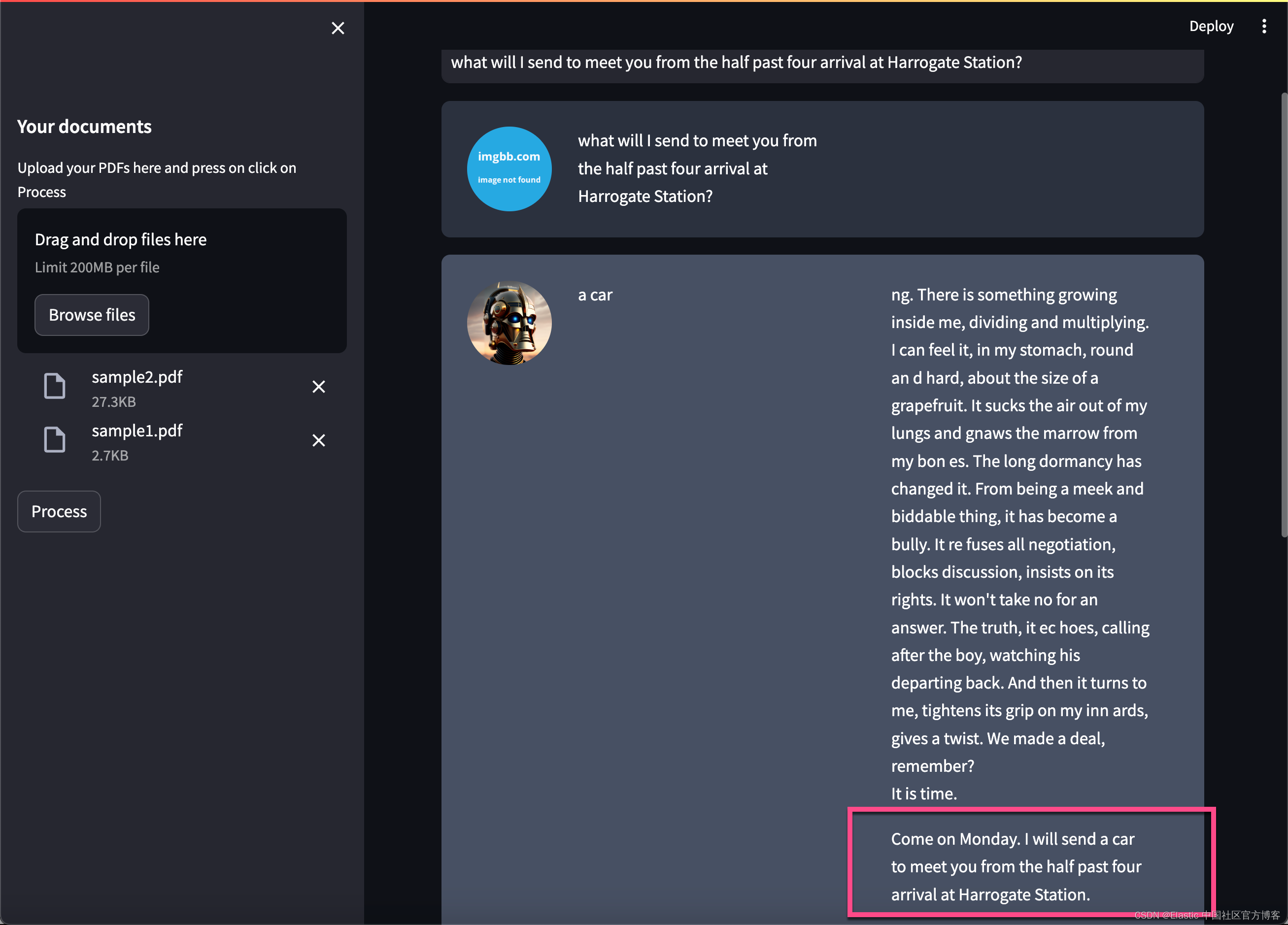
上面的问题是:
what will I send to meet you from the half past four arrival at Harrogate Station?你进行多次尝试其它的问题。Happy journery :)
有关 ChatGPT 的使用也是基本相同的。你需要使用 ChatGPT 的模型及其相应的 key 即可。在这里就不赘述了。





